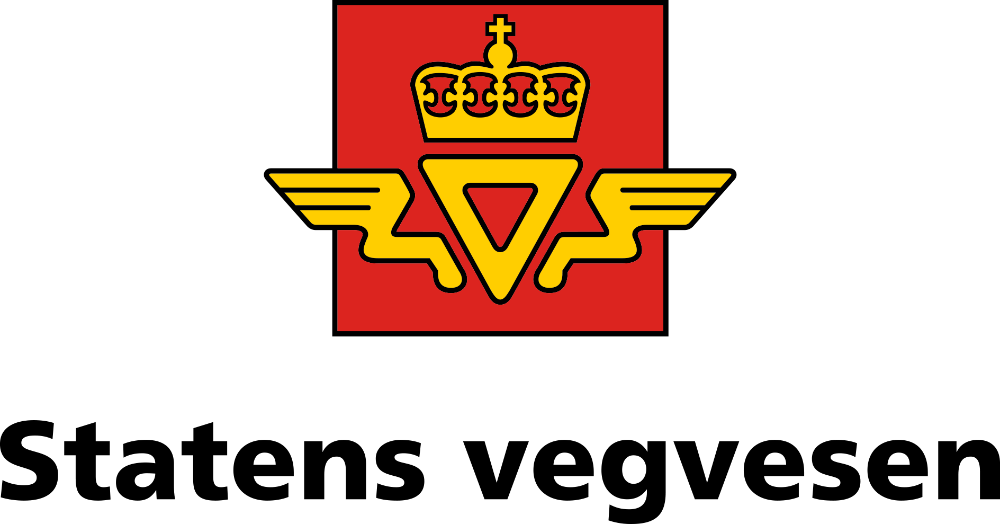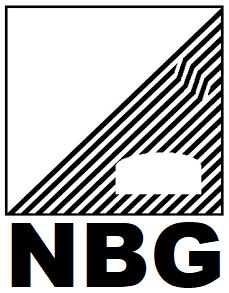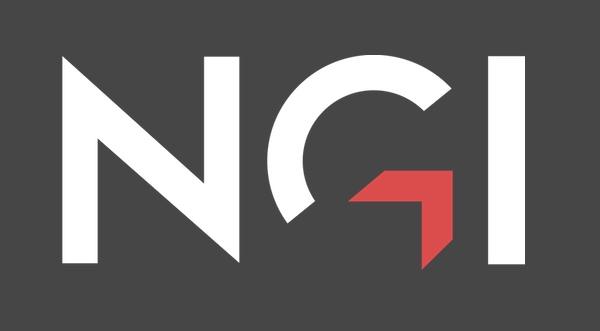ROCARC - Rock anchoring for stabilization of infrastructures
ROCARC - Rock anchoring for stabilization of infrastructures
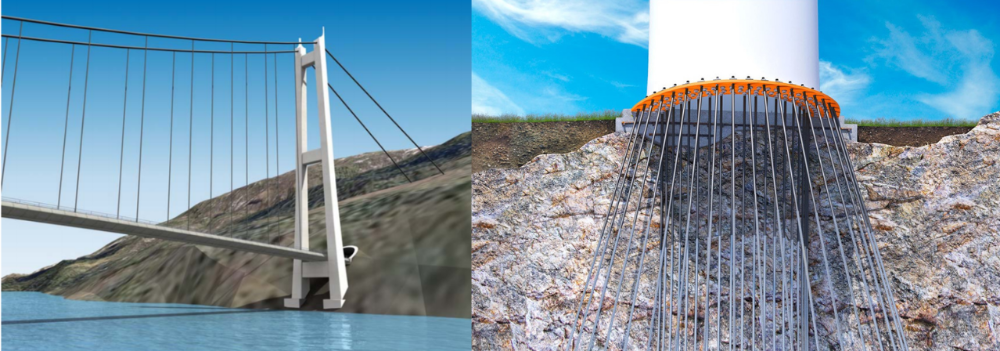
The project lasts for four years, from 1 August 2020 to 31 July 2024. It is financially supported by Research Council of Norway (RCN) as well as the research institutions and industrial partners in the consortium. One doctoral student and one post-doc are involved in the project. The host institution of the project is Department of Geoscience and Petroleum, NTNU.
Project description
High capacity rock anchors are used to stabilise rock slopes, retaining walls and large-scale infrastructures (Fig. 1a and b). Failure of the rock anchors would jeopardise the infrastructures and lead to serious economic and social consequences. Rock anchors are composed of a single or multi strands of cables which have a bonded length that is fixed deeply in the rock mass and a free length that is attached with fixture units on the ground surface. The current rock anchor dimensioning has some uncertainties because of the limited knowledge in the failure of the rock mass and the rock-grout bond strength (Fig. 1c). New knowledge in rock anchoring is required to improve the rock anchor design and to enhance relevant engineering education.
ROCARC aims to develop an updated method for the dimensioning of rock anchors. The investigations include, among others, the load transferring between the anchor and the rock mass, the failure mode of the rock mass, and the bond strength between the grout and the rock. The research will be carried out through laboratory model tests, field trials and numerical modelling. The laboratory tests aim to study how the rock mass responds to the anchor load and how the failure is initiated and propagates in the model materials. A two-dimensional test rig will be constructed for the model tests, where the deformation and load transferring in the model materials will be monitored. The field trials are carried out in rock masses to investigate how the anchor load is transferred to the rock mass and how the conical failure surface is formed in the rock mass. Pullout tests of full-scale rock anchors are also carried out in the field to formulate a realistic method for determining the rock-grout bond strength. Numerical modelling is used both in the laboratory and field tests for parameter studies and for the help of test design. In the end, a numerical modelling methodology will be established for rock anchor design.
Fig. 1. Examples of pre-stressed anchors and failure modes of a rock anchor. (a) Anchors supporting a retaining wall, (b) anchors stabilising a dam and (c) schematic of four failure modes of a rock anchor: 1 – failure in the rock, 2 – failure at the grout-rock interface, 3 – failure in the anchor-grout interface, and 4 – rupture of the anchor strand.
ROCARC Annual Seminar in 2021
The annual seminar of the project ROCARC was held on 10 November 2021 in NTNU. The participants were people from the consortium partners and some external experts in the reference group of the project. The following six presentations were delivered in the seminar:
- A brief of the project progress, Charlie Li, IGP/NTNU.
- Laboratory tests on the failure mode of frictional and low-cohesive materials under of a ground anchor, Hanna Høgset, NTNU/Rambøll.
- Laboratory tests and numerical modeling of block models for evaluation of rock mass behaviour when subject to an anchoring load, Karsten Aasbø, NTNU/NCC.
- A literature study and field pull tests in Tromsdalen, Bjarte Grindheim and Charlie Li, NTNU.
- Rock bond strength site investigation tests, Andris Bērziņš, Peikko Group Corporation Latvia.
- Road cut support using partial factor and safety factor methods, Johanne Austad, NTNU; Are Håvard Høien, NPRA.
Laboratory model tests in frictional and low-cohesive materials
Two-dimensional physical model tests were carried out on a mini test rig to study the failure pattern of frictional and low-cohesive materials under a concentrated upward load in the middle of the model which simulated the loading condition of a rock anchor. The anchor block in the model transferred the load to the material through friction at the block-material interface. A conic failure body was uplifted to the end both in the frictional and low-cohesive materials.
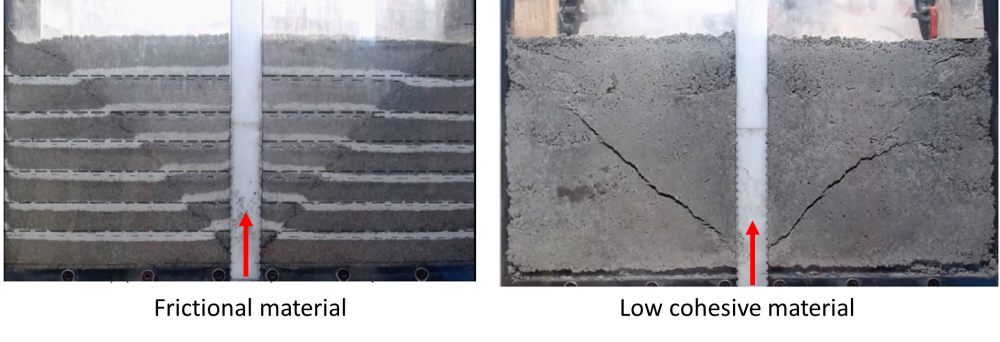
Laboratory tests of block models
Two-dimensional block models were tested in the same loading means as the tests of the frictional and low-cohesive materials on the mini test rig to study the load-arching effect in blocky rock masses and also the failure pattern of the blocks under the load of a rock anchor. The full-field strains were measured by DIC technology. The load-arching effect was clearly observed in the block models. The failure pattern is also conic in the block models.
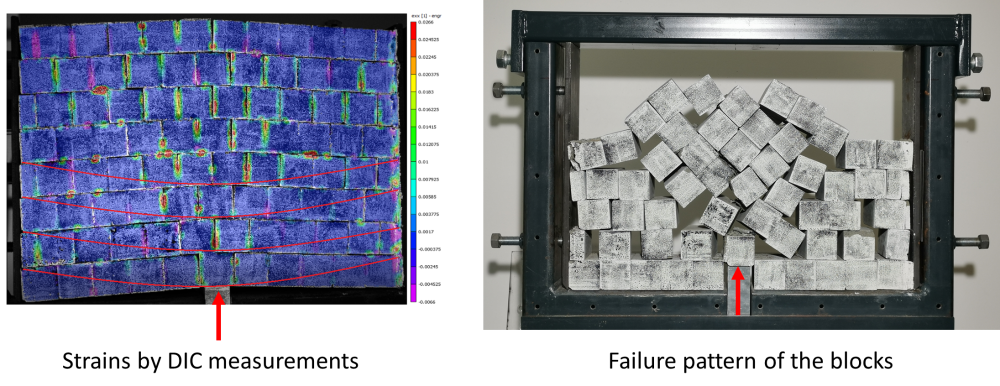
Field pull tests of rock anchors
Full-scale field pull tests were carried out in limestone quarry to test the load capacity of the anchors with different anchoring schemes. The tests showed that the anchoring method affected the behaviour of the rock anchor. The results of the field tests are under analysis at present.
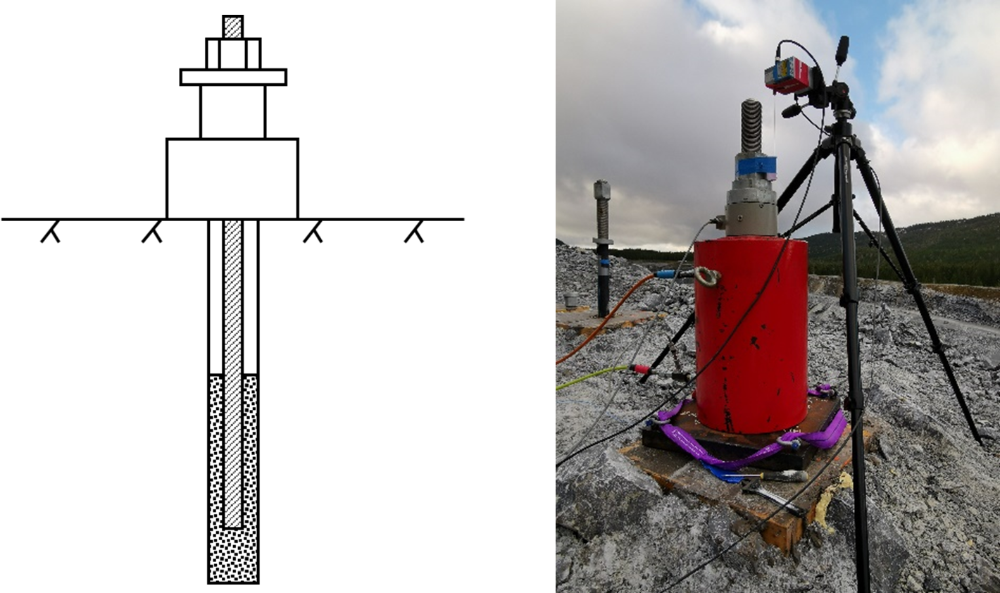
ROCARC Webinar 2020
Knowledge Exchange in Rock Anchoring
Summary
The webinar was successfully organised on 18th November 2020, from 9h00 to 13h40. Number of attendees was 97, mostly from Scandinavian countries. There were also attendees from Colombia and Vietnam.
As planned, a total of 8 presentations were presented. Presenters and titles with link to presentations:
- Charlie Li, IGP/ NTNU, Introduction to the project ROCARC - Rock anchoring for stabilization of infrastructures with focus on the arching effect and rock-grout bond
- Magnus Sørensen, Multiconsult, 2D-modellering av bergforankrede vindturbinfundamenter
- Mahdi Shabanimashcool, NGI, Rock anchored foundations for wind turbines - 3D modelling
- Andreas Ongstad, Norconsult, Forankringer i berg - FoU og praksis i Norconsult
- Leif Lia, IBM/ NTNU, Rock anchors on Norwegian dams
- Peter Lundqvist, Vattenfall, Sweden, A new guideline on post-tensioning tendons for dam-owners in Sweden
- Tor Harald Hanssen, Comrod Utility Systems AS, Fundamentering av kraftmaster - historien, utfordringer og tester gjennomført av Comrod
- Jessica Ka Yi Chiu, NGI, Anchorage of tower foundations in rock - Classification of rock ground and design rules
During the webinar, lot of issues were presented and discussed. The mentioned issuses were:
- Considerations during analytical calculation of capacity of the rock anchoring.
- Numerical modelling (2D, 3D) of rock anchoring in different rock mass conditions.
- Measurements in anchoring.
- In-situ test of anchor.
- Application of rock anchoring in dams and spillways.
- Application of rock anchoring in windmill and power transmission lines.
- Failures of anchoring.
Lot of knowledge has been exchanged between industry and academic as well as between professionals.
PDF-file of SUMMARY: ROCARC Webinar 2020
News
19. December 2023 - The fourth journal paper published: Grindheim, B., Li, C.C., Høien, A.H., Lia, L. (2023) Behavior of a Rock Mass in Uplift Field Tests of Rock Anchors. Rock Mech Rock Eng.
24. November 2023 - A presentation from the project was given at Bergmekanikkdagen. In proceedings: Høgset, H.M., Høien, A.H., Li, C.C. (2023) Modellforsøk og numerisk simulering av overbelastning av forankringsstag i friksjons- og lavkohesive materialer (In Norwegian). Fjellsprengningskonferansen 2023.
09.-14. October 2023 - The project presented at the ISRM Congress 2023 in Salzburg. In proceedings: Grindheim, B., Li, C.C., Høien, A.H. (2023) Full-scale Pullout Tests of Rock Anchors in Limestone Testing the Interfacial Bond Strengths. ISRM Congress 2023. OEGG; Salzburg.
24. August 2023 - The third journal paper published: Høgset, H.M., Høien, A.H., Li, C.C. (2023) Laboratory Investigations on the Mode of Failure in Frictional and Low-Cohesive Materials Under the Load of a Ground Anchor. Geotech Geol Eng.
June 2023 - The third master's thesis in the project by Brage Angell: Laboratorietester av blokkmodeller og opptrekkstester i felt for å undersøke bergmassens atferd når den utsettes for belastning fra forankringer.
24.-26. May 2023 - The project had two presentations at NROCK 2023 in Reykjavik. In proceedings: Grindheim, B., Li, C.C., Høien, A.H. (2023) Full-scale pullout tests of rock anchors in limestone testing rock mass uplift failure. NROCK2023. JTFI IGS and JGFI; Reykjavik.
Grindheim, B., Li, C.C., Høien, A.H. (2023) Large-scale laboratory model tests simulating rock mass uplift failure. NROCK2023. JTFI IGS and JGFI; Reykjavik.
11. May 2023 - The second journal paper published: Grindheim, B., Li, C.C., Høien, A.H. (2023) Full-scale pullout tests of rock anchors in a limestone quarry focusing on bond failure at the anchor-grout and grout-rock interfaces. J. Rock Mech. Geotech.
25. November 2022 - An overview of the project was given at Bergmekanikkdagen. In proceedings: Grindheim, B., Li, C.C., Høien, A.H. (2022) ROCARC - Rock anchoring for stabilization of infrastructures, ei oversikt av prosjektet og arbeidet så langt (In Norwegian). Fjellsprengningskonferansen 2022.
31. October 2022 - Ph.D. Cristobal Javier Manquehual started as a postdoc in the project.
3. October 2022 - The first test in the ROCARC testing rig was conducted.
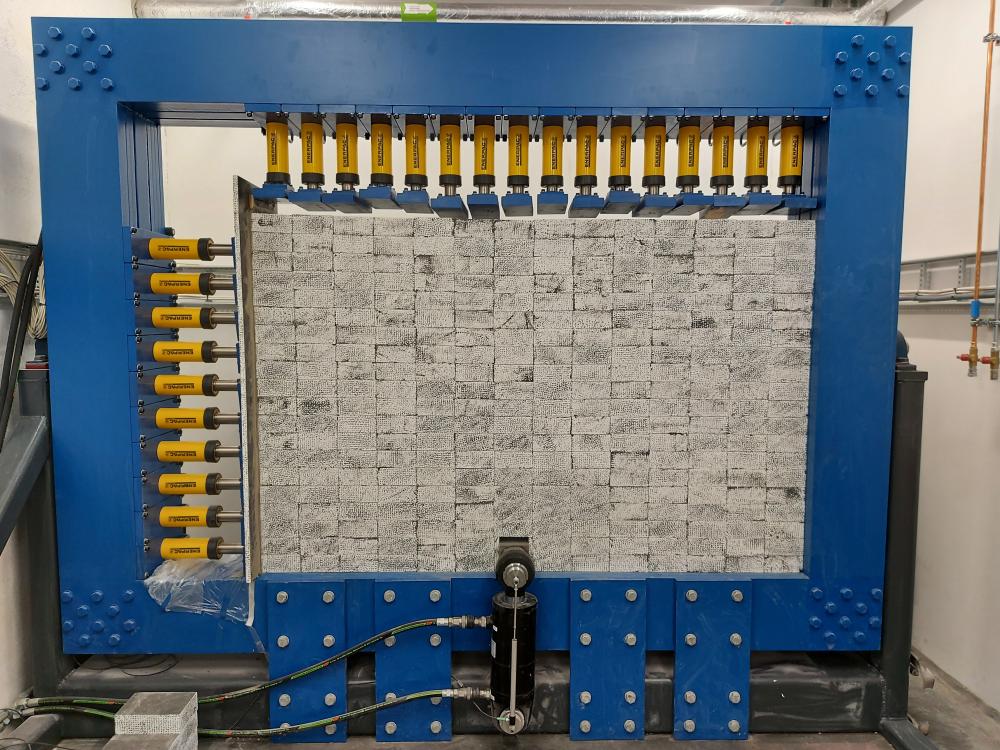
12.-15. September 2022 - The project presented at EUROCK 2022 in Helsinki. In proceedings: Grindheim, B., Aasbø, K.S., Li, C.C., Høien, A.H. (2022) Laboratory block model tests simulating rock anchoring in rock mass. IOP Conference series: Earth and Environmental Science.
6. August 2022 - The first journal paper published: Grindheim, B., Aasbø, K.S., Høien, A.H., Li, C.C. (2022) Small Block Model Tests for the Behaviour of a Blocky Rock Mass Under a Concentrated Rock Anchor Load. Geotech Geol Eng.
19. May-16. June 2022 - The second field tests were completed. Rock mass failure through pullout of 4 rock anchors at Verdalkalk.
10. November 2021 - The annual seminar of the project ROCARC was held in NTNU.
July 2021 - The second master's thesis in the project by Karsten Sannes Aasbø: Laboratory Tests and Numerical Modelling of Block Models for Evaluation of Rock Mass Behaviour when Subjected to an Anchoring Load.
6.-29. October 2021- The first field tests were completed. Pullout testing of 14 rock anchors at Verdalskalk.
March 2021 - The first master's thesis in the project by Hanna Høgset: A Study of Failure in Frictional and Low-Cohesive Material under the Load of Ground Anchors through Small-Scale Physical Model Tests and Numerical Simulations.
18. November 2020 - ROCARC Webinar 2020: Knowledge Exchange in Rock Anchoring.
13. August 2020 - Kick-off meeting: The kick-off meeting of the project was held digital via Teams on 13. August 2020.
Meeting participants: Charlie Li, NTNU; Bjørn R. Sørensen, UiT; Lisbeth-Ingrid Alnæs, SINTEF; Nghia Quoc Trinh, SINTEF; Kristoffer Lund Vik-Langlie, NTNU; Andreas Wuestefeld, NORSAR; Roger Olsson, NGI; Are Håvard Høien, Statens vegvesen direktorat; Hugo Vanje-Remlo, UiT; Per Heimli, Multiconsult; Hanne Elisabeth Wiig, NBG; Andreas Ongstad, Norconsult; Bjarte Grindheim, NTNU; Leif Lia, NTNU
10. August 2020 - Doctoral student Bjarte Grindheim started his study in the project.
20. February 2020 - Statens vegvesen finaniserer modellforsøk av fjellforankring med stag.

Hanna Høgset, student IGP, Are Håvard Høien, Statens Vegvesen, Karsten Sannes Aasbø, student IGP og Charlie Chunlin Li, professor IGP
Organisation
Consortium members:
- Department of Geoscience and Petroleum (IGP) NTNU
- Department of Civil and Environmental Engineering (IBM) NTNU
- University of Tromsø (UiT)
- Norwegian Public Roads Administration (NPRA)
- Norwegian Group for Rock Mechanics (NBG)
- SINTEF Building and Infrastructure
- Norwegian Geotechnical Institute (NGI)
- NORSAR
- Multiconsult AS
- Norconsult AS
Support member:
Rocarc
WP1 Management
Leader: Charlie Li, NTNU
WP2 Laboratory test
Leader: Are Håvard Høien, NPRA
are.hoien@vegvesen.no
WP3 Field tests
Leader: Leif Lia, NTNU
WP4 Num. modelling
Leader: Roger Olsson, NGI
roger.olsson@ngi.no
WP5 Dissemination
Leader: Nghia Trinh, SINTEF
nghia.trinh@sintef.no
Files from events
2023
- Journal paper no.2
- Journal paper no.3
- Journal paper no.4
- ISRM Congress 2023
- NROCK 2023
- Bergmekanikkdagen 2023
- Finished master's thesis
2022
- Journal paper no.1
- EUROCK 2022
- Bergmekanikkdagen 2022
2021
- ROCARC annual seminar 2021
- Finished master's thesis
2020
- ROCARC Webinar 2020 - Knowledge Exchange in Rock Anchoring



